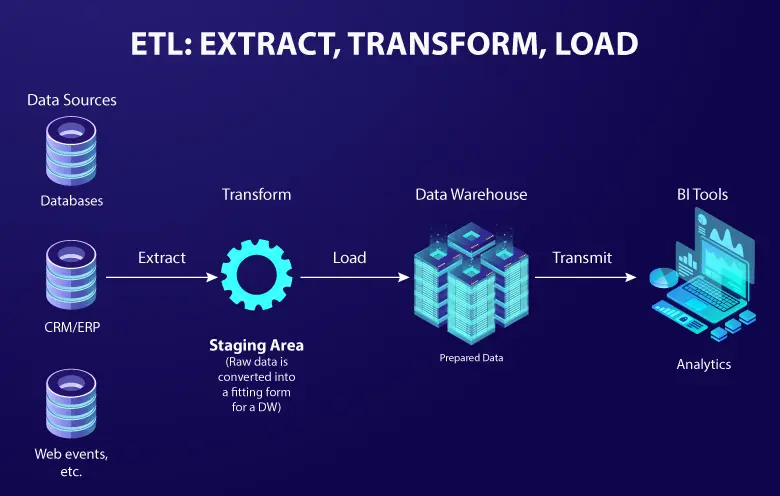Data engineering is the process of collecting, storing and processing data for further analysis and decision-making. Businesses that can collect, store and analyze data effectively have a significant advantage over their competitors.
McKinsey Global Institute says that data-driven organizations are 23 times more likely to acquire customers, 6 times as likely to retain customers, and 19 times as likely to be profitable.
There are many reasons why data engineering is crucial. Here are a few important ones:
- You can learn about your customers’ behavior, preferences and needs. This information can be used to improve products and services, target marketing campaigns and increase customer satisfaction.
- You can identify trends, forecast demand and make better decisions about pricing, product development and marketing.
- You can identify areas to improve efficiency, such as reducing costs, increasing productivity and improving customer service.
In this blog, we will discuss the challenges companies face when adopting data engineering. We will also provide some tips for businesses interested in implementing data engineering solutions.
1. Data quality
Data quality is a critical factor. Poor data quality can lead to inaccurate insights, which can result in inaccurate decisions. There are several factors that contribute to poor data quality, including:
- Human error
- System errors
- Data drift
The average financial impact of poor data quality on organizations is $15 million per year. – Gartner
How to improve data quality?
- Define data quality metrics. What does it mean for your data to be “accurate”? Once you know what you’re aiming for, you can start to measure your progress.
- Implement data quality checks. This can involve running automated tests on your data or having a team of analysts review it manually.
- Use data profiling tools. These tools can help you understand the quality of your data and identify potential problems.
- Create a data quality culture. Make sure that everyone in your organization understands the importance of data quality and is committed to improving it.
2. Data scalability
Data scalability is the ability of a system to handle increasing amounts of data without affecting performance. It is a critical challenge in data engineering because the volume of data is constantly growing. There are many factors that affect data scalability, including:
- The type of data
- The size of data
- The architecture of the system
IDC estimates that by 2025, every connected person in the world on average will have a digital data engagement over 4,900 times per day – that’s about 1 digital interaction every 18 seconds.
How to improve data scalability?
- Using a distributed architecture: A distributed architecture can help scale the system by distributing the load across multiple servers.
- Using caching: Caching can improve performance by storing frequently accessed data in memory.
- Using compression: Compression can reduce the size of the data set, which makes it easier to scale.
- Using cloud computing: Cloud computing can provide a scalable and cost-effective way to store and process data.
3. Data integration
Data engineering integration is the process of combining data from different sources into a single, consistent dataset. This can be a complex and challenging task, as the data may be stored in different formats, schemas and systems. There are a few factors that contribute to data integration problems, including:
- Data silos: Data silos are isolated systems that store data in different formats and schemas. This can make it difficult to integrate data from different silos.
- Data quality: Poor data quality can also make data integration difficult. If the data is not accurate or consistent, it can be difficult to combine into a single dataset.
80% of time is spent on data discovery, preparation, and protection, and only 20% of time is spent on actual analytics and getting to insight. – IDC
How to accelerate the data integration process?
- Define data integration requirements. What do you want to achieve with data integration? Once you know what you’re aiming for, you can start to plan your data integration project.
- Identify data sources. What data do you need to integrate? Once you know what data you need, you can start to collect it.
- Clean and transform data. Data may need to be cleaned and transformed before integration. This may involve removing errors, converting data types, or standardizing data formats.
- Load data into a consolidated repository. Once the data is cleaned and transformed, it can be loaded into a data warehouse or data lake.
- Develop data integration applications. Data integration applications can access and analyze integrated data.
4. Data security
Data security is one of the common challenges in data engineering. It helps with the protection of data from unauthorized access, use, disclosure, disruption, modification, or destruction. It is a critical challenge in data engineering because data is often sensitive and can be used for malicious purposes if it falls into the wrong hands. Factors that contribute to data security problems include:
- Human error
- System vulnerabilities
- Malicious attacks
IBM found that the global average cost of a data breach in 2022 was the highest ever since the dawn of conducting these reports. The cost of a data breach in 2022 was $4.35M
How to reduce data breach risks?
- Implement strong security controls: Security controls, such as firewalls, intrusion detection systems and data encryption, can protect data from unauthorized access.
- Educate employees about data security: Employees need to be educated about data security risks and how to protect data. This includes things like using strong passwords, not clicking on malicious links and reporting suspicious activity.
- Keep software up to date: Software should be kept up to date with the latest security patches. This can help protect against known vulnerabilities.
- Monitor systems for threats: Systems should be monitored for threats, such as unauthorized access attempts or malicious activity. This can help identify and mitigate security risks early.
5. Talent shortages and skills gap
There is a growing gap between the supply of qualified candidates and the skills that data engineering demands. This can be due to the increasing complexity of data science tasks, the rising demand for data-driven decision-making, or the lack of educational programs that teach data science skills.
The 29% increase in demand for data scientists year over year and the 344% increase since 2013 are just two examples of the growing demand for data scientists. – Indeed
Businesses of all sizes are using data more frequently, which drives this demand. Data is used to make better decisions, improve customer service and optimize operations. However, the supply of qualified data scientists is not keeping pace with demand.
How to bridge the gap between data engineering supply and demand?
- Invest in training and development: You can invest in training and development programs to help your employees learn the required skills.
- Partner with data engineering service providers: Third-party data engineering service providers can help you with a variety of tasks, including data collection, data storage, data processing and data analysis.
- Create a data-driven culture: You can create a data-driven culture that encourages employees to use data to make informed decisions.
How data engineering can help your business
Data engineering is a complex and challenging field, but it is essential for businesses that want to use their data efficiently. By understanding the challenges of data engineering and taking steps to address them, businesses can ensure that they can collect, store and process data effectively. The right data engineering solutions can maximize data value and drive better business decisions.
Softweb Solutions offers data engineering services to help you address these challenges. We have a team of experienced data engineers who can help you collect, store and process data efficiently and compliantly. Talk to our data engineers to inculcate a data-driven culture in your organization.



